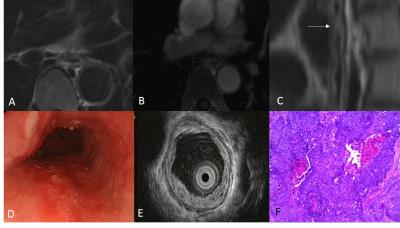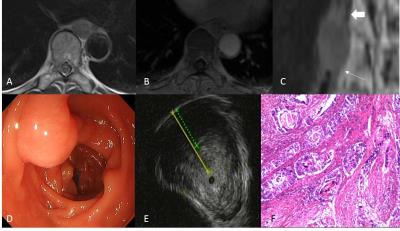4373
Preoperative T Staging of Potentially Resectable Esophageal Cancer: 3T MRI based on T2-TSE-BLADE and contrast-enhanced free-breathing radial VIBE (StarVIBE) vs endoscopic ultrasoundJinrong Qu1, Hongkai Zhang1, Hui Liu2, Xu Yan2, Zhaoqi Wang1, Hailiang Li1, Kiefer Berthold3, Nickel Marcel Dominik3, and Ihab R. Kamel4
1Radiology, the Affiliated Cancer Hospital of Zhengzhou University, Henan Cancer Hospital, Zhengzhou, People's Republic of China, 2MR Collaboration, Siemens Healthcare, 3MR Pre-development, Siemens Healthcare, 4Radiology, Johns Hopkins University School of Medicine
Synopsis
This study compared MRI based on the combination of T2-TSE-BLADE and contrast-enhanced T1 radial VIBE (StarVIBE) against endoscopic ultrasound (EUS) for T staging of potentially resectable esophageal cancer (EC). The histology confirmation of the T stage was used as reference. The results showed that the combination of T2-TSE-BLADE and StarVIBE is comparable to EUS in T staging of potentially resectable EC with lesions of T1/T2 stage, and is superior to EUS with lesions of T3/T4 stage.
Purpose: To compare MRI
based on the combination of T2-TSE-BLADE and T1 radial VIBE (StarVIBE) against endoscopic
ultrasound (EUS) for the T staging of potentially resectable esophageal cancer
(EC), with histologic confirmation of the T stage.
Materials
and Methods: Seventy-two patients with endoscopically proven EC and
indeterminate T1/T2/T3/T4a stage by CT and EUS were imaged on a 3T MR scanner
(MAGNETOM Skyra, Siemens, Erlangen, Germany). The TSE-BLADE sequence was used
for T2-weighted imaging, and a prototype T1 radial VIBE sequence (StarVIBE) was
used for the contrast-enhanced scan under free-breathing condition. T stage was
scored on MR and EUS by two independent radiologists and one endoscopist, and
compared with post-operative histologic findings. Inter-reader agreement was
also calculated.
Results: The results
of the histologic staging were: T1: 26 cases; T2: 16 cases; T3: 25 cases; T4a:
5 cases. The inter-reader agreement of T staging was good for the MRI based on
combination of and T1Star-VIBE method (Kappa=0.917, P<0.0001). EUS and histologic T staging showed a correlation coefficient
of 0.721 (P<0.0001). The correlation
coefficient of T stage score based on MR and histologic T staging was: 0.828 (P<0.0001) and 0.804 (P<0.0001) for readers 1 and 2, respectively.
High accuracy for T1/T2 staging was obtained for both readers for MRI (95.2 %
and 97.6% for reader 1 and reader 2, respectively) and EUS (100.0% for both
readers). For T3/T4 staging, MRI showed an accuracy of 96.7% for both readers,
while the EUS accuracy was only 63.3%.
Conclusion: The combination
of TSE-BLADE and contrast-enhanced free-breathing Star-VIBE is comparable to
EUS in T staging of potentially resectable EC for lesions with T1/T2 stages,
and is superior to EUS for lesions with T3/T4 stages.
Acknowledgements
No acknowledgement found.References
No reference found.Figures

Figure 1: A 53-year-old female with esophageal
squamous cell carcinoma. (A) Transverse TSE BLADE (B) Transverse
contrast-enhanced StarVIBE (C) sagittal reconstructed TSE-BLADE show tumor is
limited in mucosa (thin arrow), and mucosa is intact with MRI: T1 staging.
(D,E) EUS shows tumor invading mucosa with intact muscularis mucosa, consistent
with T1 staging. (F) Hematoxylin & Eosin (H&E) stained section at ×40
microscopy confirms that the tumor is located in the mucosa and with T1 stage.

Figure 2: A 57-year-old male with esophageal
squamous cell carcinoma.
(A) Transverse TSE-BLADE (B) Transverse
contrast-enhanced StarVIBE images (C) sagittal reconstructed T2-TSE-BLADE show
tumor invades adjacent fat (thin arrow) with MRI, and normal muscularis propria
with low signal was noted (thick arrow): T4a staging. (D,E) EUS shows tumor
invading adventitia resulting in blurred margin and consistent with T4 staging.
(E) H&E stained section at ×40 microscopy confirms that the tumor invades
adventitia with T4A stage